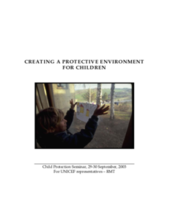In this context, the Child Protection section of the RO for CEE/CIS organized a seminar between the 29 and 30 September in connection to the annual Regional Management Team meeting (RMT). The aim was to clarify how one area of child protection concerns in the CEE/CIS region, namely de-institutionalisation of child protection approaches, is linked to a broader agenda of social policy reform. It was argued that social policy reform that is based on the principles of human rights, has a set of components which contribute to building a protective environment for children in the region.
Hence, the seminar was organized with the purpose of enhancing the insight of country representatives into the conceptual and operational challenges of social policy reforms in countries in transition. With the help of external resource people, the agenda of the seminar addressed issues in selected areas of the State’s regulatory frameworks (such as legislation, governance and the allocation of public expenditures) and examined some of the management and planning tools for action. It outlined the most widely used theoretical models and referred to examples of operationalisation and challenges some countries in the region have faced in the reform process. It further focused on components of social services, such as cash benefits and other entitlements for children and families at risk that may be used in the wider context of policy reform to overcome vulnerability.
Three panels were elaborating on different levels of concerns for the reform process:
- Social welfare in the context of social policy and governance reform;
- Expanding the legal agenda for fulfillment and protection of the rights of the child;
- Planning and management processes to enable reform of the system.
©UNICEF

